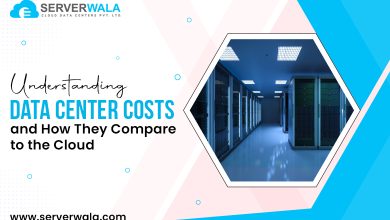The Future of Cloud Computing: Underwater Data Centers

Introduction
Welcome to the next frontier in cloud computing – Underwater Data Centers! In this blog post, we’ll dive into the innovative concept of hosting data centers beneath the waves and explore how this unconventional approach is reshaping the future of cloud computing. As the digital landscape continues to evolve, traditional data center models face challenges related to space, sustainability, and efficiency.
Enter the realm of underwater data centers, a paradigm shift that not only addresses these challenges but also opens up new possibilities for scalability, environmental responsibility, and enhanced data infrastructure. Join us on this journey as we unravel the depths of technological ingenuity and discover how the underwater data center phenomenon is making waves in the world of cloud computing.
An Overview of the Stats
Picture this: vast expanses of ocean floor housing powerful servers and data storage units. The idea might seem like science fiction, but underwater data centers are increasingly becoming a reality. According to recent industry reports, companies are investing significantly in the development and testing of submerged data centers, pointing towards a paradigm shift in how we perceive and manage cloud infrastructure.
The statistics paint a compelling picture – projections indicate a substantial rise in the deployment of underwater data centers in the coming years, with estimates suggesting a potential cost reduction of up to 30% compared to traditional on-land counterparts. The allure of increased efficiency, environmental sustainability, and improved scalability is driving this surge in interest and investment, positioning underwater data centers as a transformative force in the tech landscape. As we delve deeper into the numbers, the narrative unfolds, revealing the tangible impact and potential these submerged data centers hold for the future of cloud computing.
The Need for Migrating an Underwater Data Center
A Lack of Space Above Ground
With urban spaces becoming increasingly crowded, finding suitable locations for traditional data centers poses a significant challenge. Enter underwater data centers, which utilize the vast, unutilized spaces beneath our oceans. This migration allows for a seamless expansion of data infrastructure without encroaching on limited land resources.
In the race for technological advancement, the demand for data storage is reaching unprecedented levels. Traditional data centers, often sprawling complexes on valuable land, are struggling to keep pace with this demand. Urbanization and skyrocketing real estate costs exacerbate the challenge, making it increasingly impractical to establish and expand data centers above ground.
Underwater data centers address this constraint by capitalizing on the immense space beneath the ocean surface. These submerged facilities not only offer a solution to the scarcity of land but also present a unique opportunity for expansion without the spatial limitations experienced by their terrestrial counterparts. The ocean floor, largely unexplored in terms of technological infrastructure, becomes a vast canvas for innovation.
Beyond overcoming the space challenge, this migration to underwater data centers provides an added layer of security. The concealment and natural barriers of the ocean provide inherent protection against physical threats, reducing the risk of unauthorized access and potential sabotage.
The Ability to Serve a Larger Audience at a Lower Cost
Underwater data centers provide a unique advantage – the ability to serve a larger audience at a fraction of the cost. By tapping into the natural cooling properties of the ocean, these centers can operate more efficiently, reducing the need for extensive air conditioning systems. This not only cuts down on energy consumption but also translates into cost savings that can be passed on to users.
The traditional data center landscape is characterized by massive energy demands for cooling systems to prevent servers from overheating. In contrast, underwater data centers leverage the naturally cold and consistent temperatures of the ocean depths. The water’s cooling effect on the servers reduces the reliance on energy-intensive cooling mechanisms, leading to a substantial decrease in operational costs.
This efficiency is a game-changer in terms of scalability. With reduced operational overhead, companies can allocate resources to expanding their infrastructure and enhancing services without a proportional increase in expenses. As a result, underwater data centers enable businesses to reach a larger audience at a lower cost, fostering inclusivity in the digital realm.
Moreover, these cost savings have a ripple effect, benefitting end-users as well. With reduced operational costs, service providers can offer more competitive pricing models for cloud services. This democratization of access to advanced computing resources has the potential to bridge digital divides and make cutting-edge technology more accessible to a global audience.
Less Burden on Clean Water Resources
In an era where the demand for clean water is escalating, the traditional cooling methods employed by on-land data centers consume substantial amounts of this precious resource. Submerged data centers, on the other hand, use the ocean for cooling, eliminating the strain on freshwater resources. This eco-friendly approach aligns with the growing importance of sustainable practices in technology.
Water scarcity is an ever-growing concern, prompting industries worldwide to reassess their impact on this vital resource. Traditional data centers rely heavily on freshwater for cooling, contributing to the strain on local water supplies. The contrast with underwater data centers is stark – they harness the vastness of the ocean for cooling purposes, bypassing the need to tap into limited freshwater resources.
This shift is not merely environmentally responsible; it is a strategic move toward ensuring the longevity of essential water supplies. As climate change exacerbates water scarcity issues, the eco-friendly practices of underwater data centers become integral to a sustainable digital ecosystem.
Moreover, the use of seawater for cooling aligns with a circular economy approach. The ocean’s ability to absorb heat and disperse it over a large area provides a natural and renewable solution. It mitigates the environmental impact traditionally associated with cooling systems that discharge heated water back into rivers or lakes, potentially disrupting local ecosystems.
Fewer Failures Increase Effectiveness
Underwater data centers benefit from a more controlled environment, reducing the risk of hardware failures caused by fluctuations in temperature and humidity. The consistent and cool conditions underwater contribute to increased reliability, leading to fewer downtimes and enhanced overall effectiveness of the cloud infrastructure.
Traditional data centers, often situated on land, are susceptible to environmental variables that can impact the performance and reliability of critical hardware. Temperature fluctuations and humidity levels, inherent in many terrestrial locations, can strain servers and increase the likelihood of hardware failures. These failures not only disrupt services but also necessitate costly repairs and replacements.
Enter underwater data centers, where the ocean’s stable conditions provide an optimal environment for server housing. The cool temperatures and controlled climate reduce wear and tear on equipment, minimizing the risk of unexpected failures. This translates into increased operational efficiency, with a lower likelihood of service interruptions and improved data reliability.
The underwater setting also offers additional layers of security against external threats. Shielded from natural disasters such as earthquakes or extreme weather events, underwater data centers present a resilient infrastructure that enhances data protection and system integrity.
Also Read: What are Edge Data Centers? (Complete Guide)
Conclusion
The future of cloud computing is taking a plunge – quite literally. Underwater data centers present a promising solution to the challenges faced by traditional on-land facilities. By leveraging the vast and untapped potential beneath the ocean surface, we not only address the space constraints but also contribute to a more sustainable and efficient cloud computing landscape. As technology continues to evolve, underwater data centers may very well become the bedrock of a resilient and environmentally conscious digital future. Stay tuned as we navigate the depths of innovation in the ever-changing world of cloud computing!





